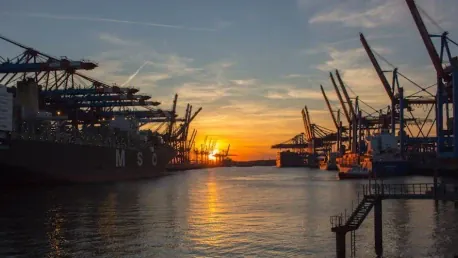The Port of Rotterdam is embarking on a significant infrastructure expansion to manage the increasing rail freight operations and enhance its competitiveness in the global market. The first phase of this project focuses on the Maasvlakte-Zuid railway yard, which includes the construction of six new 740-meter train tracks. The tracks are scheduled to be completed by mid-2027, aligning with the European standard maximum for freight rail operations.
Expansion Project
With an eye on both immediate improvements and long-term benefits, this major upgrade aims to provide the additional capacity needed to reduce bottlenecks caused by growing freight activities. These enhancements are vital for the port to maintain its efficiency and reliability while handling the steadily increasing volumes of rail freight traffic.
Project Partners
The collaborative effort underlying this expansion is reflected in the partnership between the Port of Rotterdam Authority and Swietelsky Rail Benelux BV. They have signed a contract for the first phase of construction, showcasing the strong cooperative spirit required for large-scale infrastructure projects. By working together, these parties aim to achieve a seamless integration of new capabilities with existing operations.
Standardization
The new train tracks at Maasvlakte-Zuid are designed to meet the 740-meter European standard maximum length for freight rail operations. This standardization is crucial for interoperability and operational efficiency, ensuring that the Port of Rotterdam can seamlessly connect with other major freight hubs across Europe. Meeting this standard also allows for smoother and more efficient rail operations, thereby contributing to the overall competitiveness of the port.
Congestion Mitigation
Alleviating congestion is one of the primary goals of this rail yard expansion. As freight activities continue to grow, the additional capacity provided by the new train tracks will help to substantially reduce current bottlenecks. This reduction in congestion will not only improve the reliability of rail freight services but also enhance the Port of Rotterdam’s overall operational efficiency.
Long-Term Vision
The Maasvlakte-Zuid expansion is part of a broader strategic plan outlined in the 2050 Port Rail Logistics Vision document. This long-term vision anticipates future capacity needs and encompasses various infrastructure projects slated up to 2040. These projects include track realignments and electrification programs, all aimed at ensuring the port’s readiness for future logistical demands.
Strategic Importance
Supporting Rotterdam’s position as a leading global seaport, the rail yard expansion is a critical component of the port’s long-term strategic initiatives. The projected steady growth of container throughput necessitates these enhancements, making them a pivotal aspect of maintaining the port’s global standing. Effective infrastructure development will be key to sustaining this growth while meeting the demands of an increasingly complex logistical landscape.
Conclusion
The Port of Rotterdam is undertaking a major expansion project to accommodate the growing volume of rail freight and boost its standing in the global market. This ambitious initiative is critical for the port, one of the busiest in the world, as it adapts to increased demands and evolving logistics. The initial stage of this expansion centers on the Maasvlakte-Zuid railway yard.
In this phase, six new train tracks, each measuring 740 meters long, will be built. This length is in line with the European standard for maximum freight rail operations, ensuring the port remains competitive and capable of handling the largest and heaviest freight loads efficiently. Scheduled for completion by mid-2027, these new tracks are expected to significantly improve the port’s capacity and operational efficiency. The project not only aims to enhance the logistical capabilities of the port but also to solidify its position as a major hub in international trade. By expanding its infrastructure, the Port of Rotterdam is positioning itself to meet future demands and sustain its role as a critical gateway for goods entering and leaving Europe.









